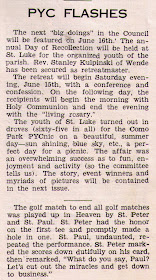Mom - our CAMZ - saved several issues of this Parish youth newsletter from her high-school years. We have two left to look over.
In June of 1946 she was having a pretty good summer as a rising senior.
Center, Page One, above the fold: a retreat is announced. Mom never mentioned Lime Lake to me, but there is a story that fits this little item to perfection.
Clara signed up for this Senior Sodality retreat. You had to bring your own lunch, so she packed a hefty one, went to Communion, went to the breakfast at the Parish hall, and stepped onto the waiting bus. She took a window seat. All the other girls - all the other retreatants - passed right by the empty seat next to her, the only Kensington High School student in the group. No one said hello to her, or tried to make her feel welcome. All the upperclassmen girls sat in a clique in the back, talking in-group talk. Pretty soon, every seat was full except for the one next to her.
Meanwhile, the Vice-President of the Senior Sodality, Gene Zdrojewski, was busy with administrative tasks on the ground. At the last minute he jumped on board, wearing his blue officer's sweater with three stripes on the sleeve, which I may show you if you are nice to me.
Wow! One seat left, and it's next to a beautiful girl!
He had no lunch, so at lunchtime she gave him a chicken sandwich. Evil rays of rage and envy shot forward from the back of the bus, but they had no power to mess anything up for these two. They never looked back.

Media vita in morte sumus, in the words of the Antiphon, "In the midst of life, we are in death." This idea these clergy applied to their youth in large part to inculcate
mindfulness. Yes, enjoy your youth; have fun; have a wonderful time; but at the same time be
mindful of serious things, such as charity to others. Your neighbor may have died, may be in mourning, or just may be the outlier in the group - alone on a crowded bus - so while you are living your life to the fullest, think of and act for your neighbor. This is the meaning of it, and this is the reason that item is on the front page right under the retreat announcement.

Page Two Staff listing credits two photographers this time: Norman and Zdrojewski.
Page Three "Thought for the Day" presents Fr. Tomiak's reminders to Sodalists that they are to strive for virtuous behavior by modeling their own after that of Mary, their exemplar of human kindness. Mary would never join in "cliques against cliques . . . pickiness, choosiness . . . behaving childishly like spoiled problem children."
I don't know who Raymond F. Roseliep was, but it would seem that he or someone close to him lost a child to rheumatic fever.
Page Four is all sports scores, while Page Five is all sports photography. Do Alt + or click to see it big in Preview.
Bottom right is a shot of
the "Tiny Terror," Bobbie Szrama, with the "Durham Flash," Eddie Nietopski.
Page Seven, bottom right, pictures a wheelbarrow race. One of those guys is wearing a blue PYC Officer's sweater, blue with white stripes on the sleeve.
There is a second sense here of
Media vita in morte sumus. All these photos were taken by two returned veterans. Surrounded by scenes and sounds of life, youth, health, and joy, the young men took their images.
(
Lots of them! If you want anything done efficiently, hire a vet.)
Yet all the while, they had images in their heads of the antitheses of those things: death, decay, cruelty, and despair, which they had seen and had had to deal with.
Carrying this around inside while carrying on with life must have constituted another battle for them, one that, for many, continued for the rest of their lives.
Julie




















































